Colonel James MacDonnell’s Regiment of Foot
Written histories of the Irish Brigade tend to have been fabricated by the Victorians who littered this history with romantic frilly nonsense. Little is actually known about the 1,500 men of the Brigade.
The Irish Brigade were sent to Scotland in order to support Montrose by the Earl of Antrim. Three regiments made up the Brigade, this regiment was commanded by Colonel James MacDonald. Not much is known about James, he is quite possibly the illegitimate son of the Earl of Antrim, but that is by no means definite. The Earl had three sons prior to getting officially married - James is most likely the youngest of the three.
Raised in 1644 they were shipped over to Scotland and almost immediately took to the field at Tippermuir where they mustered 400 men; they then fought at Aberdeen; by February 1645 at Inverlochy their numbers had halved to 200; they fought at Auldearn, Alford and finally Kilsyth. What remained of the regiment is unknown, but we do know that James returned to Ireland where he led the regiment into battle again at Knocknanuss (November 1647), for the Catholic Confederacy.
These are pretty much straight out of the bag, augmented by a Scots highlander officer (waving around a big sword), two halberdiers (one with a headswap for an Irish hat), three lowland musketeers and two highland musketeers. Somewhat annoyingly the Irish pike open hand pack aren't open handed - you're still going to have to drill their hand out (very easy to do, but if a pack is advertised as open hand I don't expect to have to drill hands out). The pikemen are slightly taller and thinner than my other figures: hopefully this is just a one off and not scale creep. Generic musketeer casualty with paint conversion legwear with a custom casualty marker from Warbases.
They carry one of the known Irish Brigade flags - alas we don't know which regiment carried which colour, so I picked three of the six described flags and assigned them at random to my three Irish Brigade regiments. Flag, as always, from Maverick Models.
Update: since discovering the primary source material for the Catholic Confederacy flags (see here) I've reflagged the regiment. Here's what they look like now...
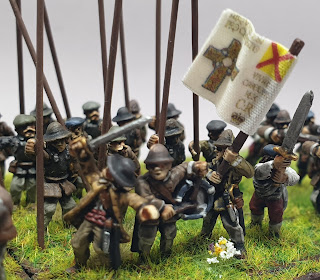







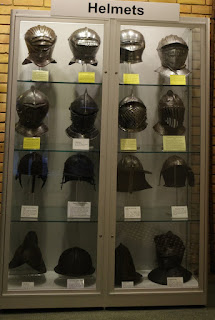
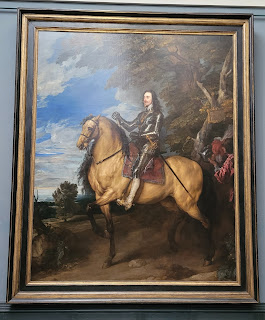

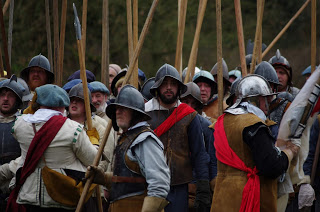
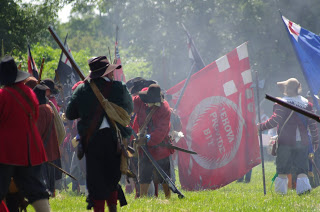



The little that's known about the Irish Brigade includes a list of officers. The Brigade certainly recruited from the North of Ireland, particularly in an area known as The Route, a place I grew up in. That list of officers almost reads like my old school attendance register; a lot of the names are immediately recognisable. Nice work btw and I am so glad you steered away from any hint of green uniforms!
ReplyDeleteThanks Dex. I was sat in a pub about a year ago with two old classmates; we could still rattle the register off almost perfectly after far too many years. To see that list replicated in a historical list must be pretty strange.
DeleteJust been looking at O'Cahan's regimental lists, five in the list of thirty officers' names that exist, were relatives of O'Cahan.
(As for green - don't look too closely, there's some wearing Foundry moss 29B coloured coats in there somewhere)
Lol! The moss is not modern Leprechaun Green so easily forgiven. When you come to Sandy MacDonnell's/ Laghtman's Regiment you'll also see the M(a)cHenrys! There is still a trace of a Dal Riadan legacy, particularly in the Glens of Antrim, with related family branches in NI and the Western Islands and Highlands. To be fair, I think that family connection within units was also the case in England during the Civil Wars, although maybe not to the same extreme extent.
DeleteIt's really exciting finding a familial connection to events from this time. I found a connection to Holland's RoF, as well as the connection to Lancashire's finance committee.
DeleteI just finished reading about Knocknanuss in Cassel's Battlefields of Britain and Ireland. The battles sound interesting: armies trying to fight somewhat conventional battles in terrain that wasn't conducive to such fightung.
ReplyDeleteI'd recommend Highland Warrior: Alasdair MacColla and the Civil Wars by David Stevenson. One idea it puts forward is that the 'Highland' Charge was actually invented by members of the Irish Brigade. There is some interesting evidence cited. But, I also wonder how much the troops were driven by a) limited ammunition and b) having to get through a hostile fire zone as quickly as humanly possible. Irish Confederate forces particularly seem to have suffered from this.
DeleteThe events that took place in Ireland are very much unrepresented in traditional histories of the English Civil War. (With the exception of Cromwell's atrocities, and even then sort of brushed under the carpet.)
DeleteMaybe with the rebranding to Wars of the Three Kingdoms such events will become better known.
Knocknanuss, both the battle and events leading up to it, are fascinating.
Thanks for the book recommendation Dex
Delete"...I also wonder how much the troops were driven by a) limited ammunition and b) having to get through a hostile fire zone as quickly as humanly possible."
DeleteThe blurb on Alasdair MacColla on Wikipedia suggests that the Irish fired a salvo at close range and used the cover of their own gun smoke to advance quickly to melee; perhaps that comes from Stevenson?
I too have recently read that the 'Highland charge' was Irish in origin but somewhat annoyingly can't remember where I saw it.
DeleteAs for Stevenson my copy is due to arrive today or tomorrow!